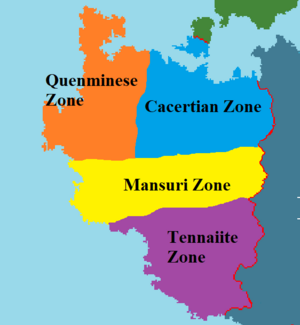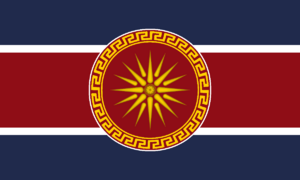Occupation of Syara
Common Axis Occupation of Syara Republika Sijara | |
|---|---|
| 1938–1956 | |
|
Flag | |
 | |
| Capital | Zovahr |
| Government | Military Occupation |
| History | |
| 1938 | |
• Withdrawal of Cacertian forces. | 1956 |
| Population | |
• 1940 | 94,000,000 |
• 1955 | 100,000,000 |
| Currency | Drachma |
The Occupation of Syara was carried out by the powers of the Common Axis from 1938 to 1956. The occupation began following the end of the Siduri War with the signing of the Treaty of Debrecen, and continued until the final withdrawal of the last Common Axis forces in Syara. Syara was divided into four occupation zones with each zone managed by a member of the Common Axis. The occupation is generally divided into two phases; the initial disarmament phase from 1938-1939, and the oversight phase lasting from 1940-1956.
Background
Following the resignation and suicide of President Sasko Anastasov, the Republic of Syara sued for peace to bring an end to the Siduri War. Negotiations were held in recently liberated Debrecen between representatives of the Common Axis powers and Syara. The terms of the treaty required Syara to withdraw all its military forces to its pre-war borders, demobilize its armed forces and dismantle much of its military hardware. To ensure this was carried out, the Republic would be jointly occupied by the Common Axis powers. The Treaty of Debrecen was signed on 10 February 1938 and went into effect the next day.
Although the occupation of Syara was agreed to, no end state was officially identified. Ruvelka was incensed by the treaty, which failed to return the region of Zemplen back to the Principality, which had been seized by the Syarans during the Ruvelkan Civil War. The Cacertians leading the negotiations however had feared the igniting of ethnic tensions would prevent the complete cessation of hostilities and insisted that the pre-war borders be respected. Debrecen eventually yielded and Ruvelkan forces did not directly participate in the occupation, though Ruvelkan infrastructure and resources were utilized by the occupying powers at various points during the occupation.
Occupation Zones
Syara was divided into four occupation zones, each one falling under the responsibility of one of the Common Axis powers to maintain and administer. The Cacertian Empire took control of much of northern Syara within the Realm of Makedon, utilizing the Syaran naval base at Sena which became known as Joint Operations Center Sena for the Cacertian Royal Navy. The Cacertians were also responsible for Syaran Chryse. Northern and central Scitaria were occupied by Quenmin, with their headquarters in Slocova. Mansuriyyah was responsible for much of Galania and southern Scitaria, with a headquarters in Cuprasi. Tennai established its mission in Hayreniky and parts of southern Galania, with headquarters in Dateva.
Disarmament
Per the Treaty of Debrecen, the Armed Forces of the Syaran Republic were to stand down and be disarmed of most of their military equipment. The exact number or required amount to be disarmed was never fully established in negotiations, only that the Syara would be restricted to military equipment "necessary for national defense". At the end of the Siduri War, Syara had amassed 17,000,000 rifles, 7,400,000 handguns and revolvers, 3,500,000 machine guns, 1,500,000 mortars, 5,233 tanks (of which 3,299 were operational), 14,625 aircraft (of which 9,880 were operational), 12,650 artillery pieces of all types, 33,960 trucks, 279 warships of all types, 4,400,000 tons of ammunition, and approximately 1,000,000 tons of fuel.
What to do with Syara's military equipment and weaponry was the subject of debate within the Common Axis. While some hardware, like the Amycus and Rhaecus tanks and 25-mm anti tank guns had been rendered obsolete by the technological progress of the war, the large number of automatic weaponry, 75mm guns, artillery, and some aircraft were still considered useful. The outbreak of the Eracuran War the previous year had also created a large market for surplus military equipment, and the Common Axis had already been petitioned regarding the fate of Syaran military hardware. Ultimately 90% of Syaran ground forces equipment was either scrapped or repossessed by the Common Axis. This produced nearly 2,000,000 tons of scrap metal by the end of disarmament.
What to do with Navy of the Syaran Republic's remaining warships provoked considerable debate within the Common Axis. By the end of the war Syara still possessed one aircraft carrier, nine modern battleships, four battlecruisers, 37 modern cruisers, 70 submarines, 122 destroyers, and 41 sloops, patrol boats, and auxiliary cruisers. It was agreed that the fleet should be split up and distributed to the victorious powers, but it was uncertain how the fleet should be proportioned. The Cacertians, by virtue of having lost more ships than any other Common Axis member, could lay claim to the majority of tonnage, but the other powers requested that they also receive warships to augment and reinforce their own fleets. There was also concern that some of the Eracuran powers, in need of warships themselves, would request to purchase them, or possibly even seize them for their own use. It was eventually agreed that the Syaran fleet would be escorted to Cacerta and afterwards distributed among the Common Axis.
However on 15 March 1938 the Cacertian Center Fleet arrived in Moddra to learn that the Syarans had scuttled their own ships rather than let them fall into Common Axis hands. None of Syara's battleships, battlecruisers, or heavy cruisers remained afloat. The Syarans later scuttled their remaining aircraft carrier the same day, leaving the Common Axis to seize what was left. Several warships were later re-floated, but none returned to service and were eventually scrapped.
